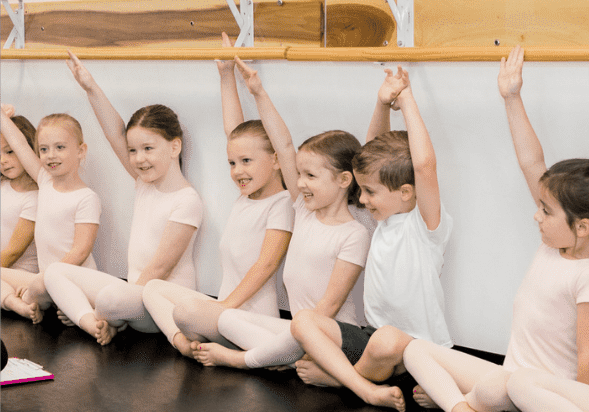Give Them Something to Talk About

Today, I’m sharing five strategies to combat a chatty class. I’ll admit, my early elementary class is probably the loudest you will ever hear, but it’s not because my students are off-track. It’s because I always give them something to talk about.
Here’s how…
Focus on Class Objective. As a conceptual teacher, each of my classes focuses on a dance concept. This is our theme or “word of the day”, as I like to call it. As we work through our class, I’ll emphasize that concept and have the dancers repeat it back to me. For example, if our word of the day is ENERGY (Smooth/Sharp), every time we do a smooth plié or sharp sauté, we will say the word as we perform the skill. We will match our voice to the quality of movement as we plié while saying “smooooooth” and sauté while saying “sharp!”. Incorporating our voices enhances the learning experience, while keeping to our goals for the day. This also ensures that our auditory learners are hearing how the movement is supposed to feel and look.
Ask Questions. In addition to asking questions around our word of the day, I’ll also ask lots of questions to ensure my dancers are remembering and comprehending what we are learning. I’ll often ask:
“What is this called?” Perform a skill and have your dancers tell you what it is.
“How do we do a ____________?” Fill in the blank with any skill, then have them teach it to you.
“What muscles are we stretching?” This is a great way to incorporate anatomy and kinesiology into our classes. Once we identify the muscles, we can talk about how those muscles move our body.
Vocalize Hard Things. Sometimes dancers become off-track when things get hard. I curve these challenges by adding auditory cues. When we have a skill that takes a lot of energy, I’ll add a sound they have to say to emphasize that movement. For example, when we do abdominal roll ups, we let out a great big “ahhhhhhh” as we roll up. When we hold a plank or our tired arms in jazz second, we count out loud to ten, then reverse. The cues become part of our warmup and skill development. It also ensures that they are breathing, which in turn makes it easier for them to accomplish the objective.
Ditch the Music. Unless it’s serving a purpose for the class objective at the moment, I am finding myself teaching more and more in a silent classroom. This is especially helpful when we are learning something new or working through a difficult skill. Auditory distractions can get our class off-track quickly. I reel my class back in by eliminating that distraction. Don’t forget to change your volume too! My go-to is a whisper, but if it’s an especially talkative class I’ll mouth the words so they really have to pay attention.
Create Your Top 3. If your class is still struggling to focus, perhaps it’s time to create your “Top 3”. Before you begin class, grab a dry erase marker and gather your dancers by the mirror or white board. Ask them “what are three things we can do to have a successful class?” and write them down. Anytime you feel the class is getting off-track, hold up three fingers as a reminder of your top three. When I did this with my 6-9 year olds, they said 1. Listen 2. Focus 3. Do Your Best. These became our “Top 3” for the season. Rather than me listing the rules of the class, I invited them to share what they thought we needed to remember. By giving them a voice and ownership of their class, they are more likely to succeed.
Lastly, I always remind myself that many kids come to dance FOR the social aspect that class offers. After all, oftentimes dance class is the first large group social experience for our tiniest dancers. It’s normal, and developmentally appropriate, for children to want to chat with their friends and dancemates, especially when they are enjoying themselves. Making sure we offer opportunities for social interaction and collaborative moments in class will give them an outlet to release that talkative energy. And, when it’s not those times, remember to give them something to talk about!
Andrea Trench is dedicated to helping dance teachers create and deliver content that is research-based and developmentally appropriate for children under the age of 6. Her primary focus is classroom management, conceptual teaching, and foundational movement skill development in early childhood dance education. In addition, Andrea uses her 12 years of experience as a partner in a dance studio to inspire, equip, and empower educators.







